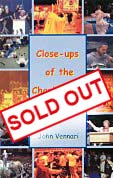The Synod, centered on Scripture, is titled “The Word of God in the Life and the Mission of the Church”, opened October 5 and will last until October 26. It is considered one of the major events of the Pauline Year.
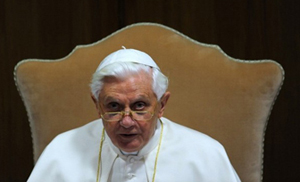
Opening the Synod at St. Paul Outside the Wall
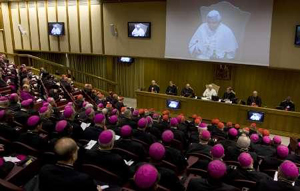 |
It will be the first Synod held not at the Vatican, but at St. Paul-Outside-the-Walls. This, no doubt, is to emphasize the ecumenical aspect of the Synod. St. Paul-Outside-the-Walls has effectively become an “ecumenical basilica” due the recent history of ecumenical milestones connected with it.
It was at St. Paul-Outside-the-Walls that Pope John XXIII first announced the Second Vatican Council in 1959. At this same basilica, Pope Paul VI, on December 4, 1965, held a special “Liturgy of the Word” service for the Protestant Observers who attended Vatican II.
St. Paul-Outside-the-Walls was the place in which Pope John Paul II announced his plans for the 1986 pan-religious prayer-meeting at Assisi, and where the same Pope opened the Holy Door for the year 2000 Holy Year flanked by the Schismatic Patriarch of Constantinople and the Anglican Archbishop of Canterbury.
St. Paul-Outside-the-Walls is also the site each year of the concluding liturgy for the Week of Prayer for Christian Unity, a once-Catholic program that has become ecumenical since the Vatican II, and now held in conjunction with the World Council of Churches.
Pope Benedict’s first Motu Proprio, issued on May 31, 2005, dealt with the canonical structure of St. Paul-Outside-the-Walls. In this document, the Pope celebrated the memory of St. Paul-Outside-the-Walls as a place of ecumenical happenings and encouraged more such enterprises in the future.
Then on January 21 of this year, Vatican Information Service confirmed that as part of the Pauline Year, St. Paul-Outside-the-Walls will open an “ecumenical chapel” wherein members of various non-Catholic sects can hold their prayer services. [1]
In announcing the Pauline year, Pope Benedict said on June 28 2007 that the Pauline Year would be characterized by the “ecumenical dimension.” [2] The October Synod proves Benedict true to his word and to his fierce attachment to Vatican II’s new program.
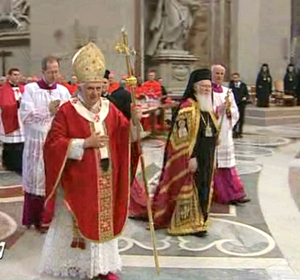
The first time a Schismatic leads a liturgical service and speaks at a Catholic Synod |
On October 18, as part of the Synod, Pope Benedict and Schismatic Patriarch Bartholomew I will preside at first Vespers. Each will give an address on the subject of Scripture, with a special reference to the Pauline Year.
It will be the first time a Schismatic Patriarch addressed the Synod Fathers. Archbishop Nikola Eterovic, secretary general of the Synod of Bishops, explained, that the Patriarch “will bring the greetings of ‘Orthodox’ Churches that the Apostle to the Nations founded before going to Rome where he suffered martyrdom.”
The Synod will also welcome other members of the Schismatic Orthodox, as well as members from various Protestant sects.
Asia News reports, “Representatives of the Ecumenical Patriarchate will be present along with others from the Patriarchates of Moscow, Serbia and Romania, from the Orthodox Church of Greece and the Armenian Apostolic Church, as well as from the Anglican Communion, the World Lutheran Federation, the Church of the Disciples of Christ and the World Council of Churches.” [3]
In another ecumenical “first” a Rabbi lectured the Synod Fathers. On October 6, Chief Rabbi Shear Yashuv Cohen of Haifa, Israel, addressed the assembly on how the Jewish people read and interpret Sacred Scripture — which is a reading of the Old Testament that has nothing to do with Jesus Christ. Nonetheless, Asia News celebrated, “It will be the first time that a rabbi, and a non-Christian, has addressed the Synod Fathers.”
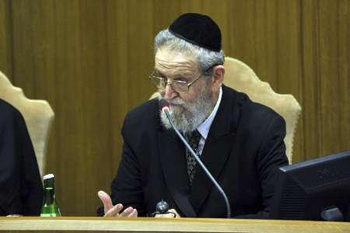
Rabbi Cohen lectures the Synod: Jews "cannot forgive and forget" that Pius XII didn't do more to help them. Below, Benedict congratulates the rabbi after his insults.
 |
Other special guests will include Rev. A. Miller Milloy, secretary general of the United Bible Societies, and Frère Alois, prior of the Taizé Community. The Synod will truly have an unprecedented ecumenical dimension.
St. Maximilian Kolbe rightly decried ecumenism as the enemy of the Blessed Mother. Saint Maximilian said, “There is no greater enemy of the Immaculata and her Knighthood than today’s ecumenism, which every Knight must not only fight against, but also neutralize through diametrically opposed action and ultimately destroy.” [4]
Our Lord gave His Apostles the duty to “go forth and teach all nations” to bring all peoples into the one and only true Church that Christ established. Ecumenism does the opposite. As the eminent theologian Father Edward Hanahoe lamented, today’s ecumenism has the effect of “perpetuating the state of separation, serving rather to keep people out of Church than to bring them into it.” [5]
It is the unchangeable teaching of the Church that any “ecumenical” contact with members of false religions can have only one purpose: to convert the non-Catholic to the Catholic Church, outside of which there is no salvation. This was the clear teaching contained in Pope Pius XII’s 1949 Instruction on the Ecumenical Movement – a teaching that conformed to the perennial Magisterium of the centuries. Here Pius XII said, "True reunion can only come about by the return of dissidents to the one true Church of Christ."
Yet the motley collection of false religions that will be visible at the upcoming Synod represents an ecumenism that Pope Pius XI condemned as a false unity "quite alien to the one Church of Christ.” [6]
Pope Benedict claims to be operating according to a “hermeneutic of continuity” that insists Vatican II contains no rupture with the past. At the same time, he launches unprecedented initiatives that have no continuity with anything in Church history, and that would have been condemned by every Pope prior to Vatican II. Sadly, this new “hermeneutic of continuity” only works for those who are prepared to abandon the principle of non-contradiction. [7]
As I have noted elsewhere, Benedict’s “hermeneutic of continuity” has little to do with re-establishing tradition. It is another failed attempt at a “new synthesis” between various aspects of Catholic Tradition and the liberalism of Vatican II. His main purpose, I believe, is not so much to rescue Tradition, but to save Vatican II, the disastrous Council on which he has built his entire ecclesiastical career. [8]
In fact, the entire notion of the regular “Synod of Bishops” is a direct application of Vatican II’s collegiality. Never before in Church history did we witness bishops from world over gather every two or three years in Rome for a month at a time to discuss a given topic to death. Synods used to be rare occasions, but they are now a permanent “collegial” structure in the Church. Most importantly, the Synod has been established in order to advance the implementation of Vatican II throughout the world over time. [9]
We see that at this latest October Synod, we will witness an advancement of the Conciliar revolution. Now Rabbis and schismatic patriarchs address the Bishops, and various non-Catholics are invited to participate.
The ecumenical element of the October Synod guarantees the perpetuation of this liberal ecumenism throughout the Church, to the detriment of Tradition. It will embolden diocesan bishops to host similar ventures, such as joint conferences on religious topics with schismatics, Protestants and rabbis. Concerned Catholics who complain of these activities will be shouted down by the Chancery. The bishop will justify his actions on the plea he is merely following the actions of the “conservative” Pope Benedict XVI.
This is scandal. There is no other word for it.
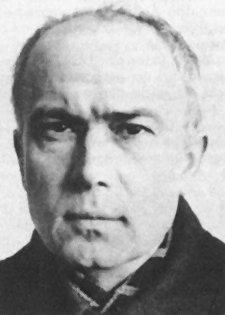
Maximilian Kolbe: ecumenism is the greatest enemy of the Immaculata. We must resist the coming Pan-religion |
Do we wonder why the world appears to be is falling apart? Why God seems to be withdrawing His blessings? What can we expect when Catholic leaders launch public initiatives that were always rightly denounced as grave sins against the First Commandment?
In 1918, Belgium’s Cardinal Mercier wrote a pastoral letter entitled The Lesson of Events in which he said that World War I, more than anything else, was a punishment for states and governments placing the one true Church of Jesus Christ on the same level as false creeds.
Mercier wrote, “In the name of the Gospel, and in the light of the Encyclicals of the last four Popes, Gregory XVI, Pius IX, Leo XIII, and Pius X, I do not hesitate to affirm that this indifference to religion which puts on the same level the religion of divine origin and the religions invented by men in order to include them in the same skepticism is the blasphemy which calls down chastisement on society far more than the sins of individuals and families.” [10]
Cardinal Mercier noted that this was a punishment for governments giving equal place to false religions. How much worse is it for Catholic leaders to effectively grant false religions legitimacy within the walls of a major Roman Basilica?
It is long past time to say “enough”! Concerned Catholics must step up their resistance to this error rightly condemned by St. Maximilian Kolbe as the “enemy of the Immaculata”. Today’s ecumenism is a manifestation of modernism and religious indifferentism. It is a central error of liberal Catholicism. There is no excuse for a Catholic to defend it or take part in it in any way whatsoever.
1. For documentation on everything said concerning St. Paul-Outside-the-Walls, see “Ecumenical Chapel at St. Paul Outside-the-Walls”, Feb. 2008, Catholic Family News. Online at: www.cfnews.org/EcuChapel.htm
2. “The Holy Father Proclaims a Year Dedicated to St. Paul”, Vatican Information Service, June 28, 2007.
3. “Synod: 253 Bishops from around the World but none from China,” Asia News, October 3, 2008.
4. Entry of Diary dated April 23, 1933. Cited from Fr. Karl Stehlin, The Immaculata Our Ideal (Warsaw: Te Deum, 2005), p.37.
5. One Fold: Essays and Documents to Commemorate the Golden Jubilee of the Chair of Unity Octave, 1908-1958, ed. by Edward F. Hanahoe and Titus F. Cranny (Graymoor: Chair of Unity Apostolate, 1959), p. 121.
6. Mortalium Animos, Pope Pius XI, 1928.
7. A thing can not both be and not be at the same time under the same circumstances.
8. This is discussed at greater length in “A Key to Benedict XVI: The Oath Against Modernism vs. the Hermeneutic of Continuity.” See www.cfnews.org/Herm.htm
9. That is how it I heard it defined by Father Kenneth Boyak, who had worked with the USCCB. I discuss more completely the notion of the Synod and it’s relation to Vatican II in “Catholicism Dissolved, the New Evangelization”, a four-part series that ran in CFN, October 1998 through January 1999. For information on this article, contact cfnjv@localnet.com
10. Quote taken from The Kingship of Christ and Organized Naturalism by Fr. Denis Fahey (Regina Publications, June, 1943), p. 36. Footnoted as cited from Cardinal Mercier’s Pastoral Letter, 1918, The Lesson of Events. (Emphasis added). See also "The Schismatic Orthodox and Conversion," [at www.cfnews.org/Ortho-convert.htm] which includes Pope St. Pius X's teaching on the necessity of the "Orthodox" to convert for salvation.

Posted October 8, 2008
|
